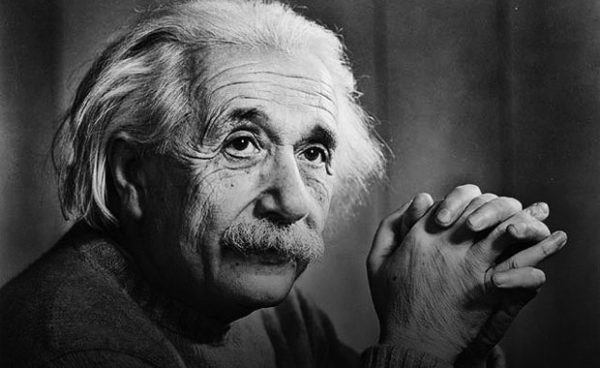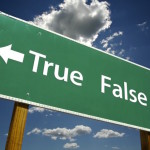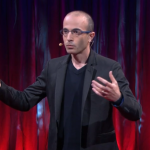Whatever is Moved is Moved By Another
by Dr. Dennis Bonnette
Filed under Philosophy

“Motion is the act of a being in potency insofar as it is in potency.” - Aristotle, Physics Book III, 201a10-11
In his famous First Way of proving God’s existence, St. Thomas Aquinas says, “It is certain, and evident to our senses, that in the world some things are in motion.”1 But, are things really in motion? Most people would think that motion in the world is too obvious to doubt. Yet, some, based on theories of modern physics, claim that physical change in the universe is actually impossible. Change or motion—meaning that “this” becomes “that” with some persisting reality exhibiting those before and after qualities—simply does not exist. Like Parmenides, those denying motion claim that our dynamically changing, evolving world is merely one grand illusion.
Despite such claims that change is unreal, philosopher of physics Tim Maudlin, well known for studying entangled quantum particles, insists, “Physics has discovered some really strange things about the world, but it has not discovered that change is an illusion.”
In his book, The Trouble with Physics (reprint edition, 2007), theoretical physicist Lee Smolin puts his finger on why physics is prone to make the mistake of saying motion and time are unreal: “…Descartes and Galileo both made a most wonderful discovery: You could draw a graph, with one axis being space and the other being time. A motion through space then becomes a curve on the graph. In this way, time is represented as if it were another dimension of space. Motion is frozen, and a whole history of constant motion and change is presented to us as something static and unchanging.”2 In other words, the static mathematical abstractions of modern physics automatically tend to omit the very starting point they presume, namely, the reality of objective motion or change.
In a new book, Neo-Aristotelian Perspectives on Contemporary Science (2017), philosopher Edward Feser points to the incoherence of physicists denying the reality of motion when their scientific method presupposes it. For example, even the simplest experiment requires watching for movement of a needle on a dial:
“When the needle moves from its rest position it loses one attribute and gains another (namely a particular spatial location), and it is one and the same needle that loses and gains these attributes and one and the same dial of which the needle is a component. If there were no gain or loss of attributes, or if the needle or dial were not the same, the observation would be completely useless.”3
Similarly, physicists presume real physical causation takes place through time with ontologically-continuous physical agents causing the continuous coming-to-be of ontologically-continuous effects. For example, the same rocket engine causes the progressive ascent of the same spacecraft into orbit. This is simply how natural science has always understood the nature of physical causation operating in the real world. That a physical theory should be interpreted as contradicting this universal scientific presupposition defies understanding.
Even if change or motion were simply a subjective illusion or a memory function product, it is still immediately recognized and judged by the intellect for precisely what it is, that is, a change. The intellect knows the nature of being and forms a concept of being that begets the universal certitude of the principle of non-contradiction – a truth about reality that scientists absolutely accept, but have no scientific way of explaining. In like fashion, the intellect judges the nature of change or motion as real when immediately experienced – no matter its size or type. Whether it is extramental or intramental change makes no difference. Static experiences alone would never beget the concept of motion, since non-motion contradicts motion.
One of the greatest philosophers of science of the 20th century, Karl Popper, says of the experience of change within consciousness, “It could not be explained away by a theory of the successive rising into our consciousness of time slices which in some sense coexist; for this kind of ‘rising into consciousness’ would have precisely the same character as that succession of changes which the theory tries to explain away.” Worse yet for materialists who deny change, if all that exists is material, then change’s reality within consciousness means that change is real in the physical universe.
We have a concept of change solely because we have encountered a reality – subjective or not – that actually contained motion. That alone explains how we even have such a concept. Yes, we form concepts of imaginary things. But, they are always composed of elements taken from real objects, as a unicorn is composed of concepts taken from real horses and real horns. Since the concept of change itself is primary, it must be based on an actually existing nature.
Nor could motion or change be experienced as such unless both the “before” and “after” of the change is present to the same knower. This fulfills change’s meaning, since “this” becomes “that” with something (the knower) persisting to both the before and after.
Therefore, change or motion is objectively real.
If some physicists cannot reconcile the immediately given reality of motion or change, as defined here, with their speculative inferences drawn from the special theory of relativity, their speculations must be wrong on that point.
Einstein’s special relativity thought experiment assumes a train moving past a standing observer. Observer, of what? Observer that the train is in motion! The observer knows it is motion because the train he observes is in diverse positions relative to his own position. So, for him there is a before and after with himself, the observer, being present to both – which fulfills the Aristotelian meaning of motion. Clearly, no speculative interpretation of special relativity can contradict the reality of the very motion Einstein’s thought experiment presupposes in its proof.
Either Einstein made a mistake in one of his assumptions, or else, one of several philosophical interpretations of special relativity compatible with motion must be correct.4 In any case, the immediately given reality of motion or change trumps any subsequently developed theory that denies its objective reality.
“Quidquid movetur ab alio movetur.” Whatever is moved is moved by another. What this famous principle really means is this: Whatever is in motion is being moved here and now by another. While motion is mostly thought of in terms of local motion – motion from place to place, any type of change can be called motion.
As seen above, motion does not mean simply one thing replacing another, like frames in a motion picture film. Rather, it means one thing becoming somehow different with some persisting reality connecting the before and after. For example, consider the same knower experiencing successive images, or, the same body moving from one position to a different position relative to some point of reference.
Aristotle defines motion as the act of a being in potency insofar as it is in potency. Easier to grasp is this description: the progressive actualization of a potency. For purposes of describing motion, potency is what is able to be, but is not; act is that which is fully real or completed. Strictly speaking, motion means local motion, a change of place. More broadly, it can mean any kind of change, any passage of something from potency to act—sometimes even instantaneously.
For a non-technical macroscopic example, consider water being heated from room temperature to boiling. Motion is not maintaining the water at 72 degrees, but progressively adding heat so as to constantly raise the temperature until 212 degrees is reached. If the “raising” stops at, say, 200 degrees, the motion stops, even though the heat must be maintained to stay at that point. Thus, the motion is not the act already achieved, namely, the 200 degrees, but the act that is achieving the potency yet to be fulfilled, that is, 212 degrees.
The reason everything in motion needs a mover is simple. A thing cannot reduce itself from potency to act and that is exactly what is happening to the thing in motion: it is being reduced from potency to act. Yet, “reduction” here does not mean less being, but more being!
A thing in motion is gaining new perfections of existence every moment it continues to move or change. Since a being cannot give to itself that which it lacks, something else must be giving to it that which it lacks, but is gaining incrementally.
Yet, how do we know this reasoning is correct? While it is easy to defend the principle in terms of the standard Thomistic analysis of potency and act, many today do not fully appreciate the full force of such reasoning.
Here is a different way to see the objective certitude of the principle that whatever is in motion must be being moved by another, one simply based on “the natural metaphysics of human intelligence.”
Everyone knows and uses the metaphysical principle of non-contradiction, that is, that nothing can both be and not be at the same time and in the same way. Even though materialist scientists cannot prove this principle or show how its certitude arises, they have no honest doubts about its universal truth and application. This is because the human intellect, once it forms the concept of being, sees clearly the necessary truth of its application to all possible things.
So too, the fact that you cannot get something from absolutely nothing is universally accepted—after you eliminate claims of getting particles from quantum vacuums that turn out to be something after all. Once it is understood that the philosopher means really nothing, every honest mind assents to the truth that from nothing, nothing comes to be.
What has this to do with things in motion? Simply this: a thing in motion is gaining new properties of being it did not previously possess. As such, with respect to those properties it did not have, it is non-being; nothing at all. Since nothing cannot beget something without extrinsic causal assistance, a being in motion must be getting this new being from something other than itself, that is, from a mover.
For a thing to reduce itself from potency to act would be for it to be giving itself the very perfections of existence that it lacks. This is equivalent to having something that is non-being in a certain respect accounting for the coming-to-be of the selfsame being that it does not have. Being coming from non-being is impossible and absurd.
The full force of this principle is not understood until it is realized that it applies even to bodies already in a “state” of motion—a motion “explained” by most moderns simply by appeal to Newton’s principle of inertia. Even those who defend the principle that motion requires a mover sometimes retreat to applying it solely to cases in which a change in inertial motion occurs. Thus, to accelerate or decelerate an object in motion is seen to require a mover, but that the object merely stays in its present “state” of motion is considered fully explained by inertia.
Part of the problem is that it may not be clear as to exactly which body is in motion, since all motion appears relative—so that if A moves relative to B, we cannot tell which body is actually undergoing the motion. In fact, it could be both. But it really does not matter at all, since all we need to know is that a change of distance or relative position between two or more bodies occurs.
Just as I have shown in a prior Strange Notions article how many confuse physical antecedents with real causes of present effects, so too, acceptance of Newton’s first law of motion as full explanation for the phenomenon of inertial motion causes many to fail to see the further need of metaphysical explanation. Modern science correctly describes the phenomenon under consideration: a body in motion tends to remain in motion. But mere description is not identical to giving an adequate explanation as to why this phenomenon occurs at all.
Calling motion a “state” does not render it static. All motion still requires the continuous reduction of potency to act. And since nothing can give to itself the new perfections or qualities of existence that it lacks, some extrinsic reason or cause must account for the coming-to-be of those changes.
This applies just as much to bodies in a “state” of inertial motion as it does to objects that are accelerating or decelerating. Nor does it matter which object is considered to be in motion, since any change in spatial relation or any other kind of relation between things entails a real change in something—and that requires some extrinsic agent or mover to complete the explanation of what is going on—to account for the “new being” that is manifested, even if that new being is merely a change of relative position. Some outside agent must exist to account for the coming-to-be of the new existential qualities manifested by these new spatial relationships.
Newton’s first law of motion is not an exception to the principle that whatever is in motion requires a mover here and now continuously providing the new modes of existence manifested by continuing change or motion.
Of course, local motion is only one type of motion, but it is one of central occupation to physical science. The principle in question applies to every conceivable type of change, not only of local motion, but also to changes of quality, relation, size, disposition, time, and so forth. It can even be applied to spiritual changes that entail no gradual change. That is, even an instantaneous change by which a potency is actualized requires an extrinsic agent to effect the change, as when a fresh insight suddenly “pops” into one’s mind.
Much more can be said, but this should be enough to demonstrate that the philosophical principle that whatever is in motion is moved by another is absolutely certain and universally true.
This principle is not merely a principle of natural philosophy, but of metaphysics as well—since motion, which is the progressive actualization of a potency, entails that something is gaining new qualities of being. A being in motion must be getting this new being from something other than itself.
All of this shows that this principle is a principle of being, just like the principle of non-contradiction. As such, just like the concept of being and the principle of non-contradiction, it applies to all beings and can be used in an analogical manner, even possibly to reason from finite being to infinite being in a transcendent fashion. This, of course, foreshadows a role for this principle well beyond the topic at hand.
Related Posts
Notes:
Note: Our goal is to cultivate serious and respectful dialogue. While it's OK to disagree—even encouraged!—any snarky, offensive, or off-topic comments will be deleted. Before commenting please read the Commenting Rules and Tips. If you're having trouble commenting, read the Commenting Instructions.













